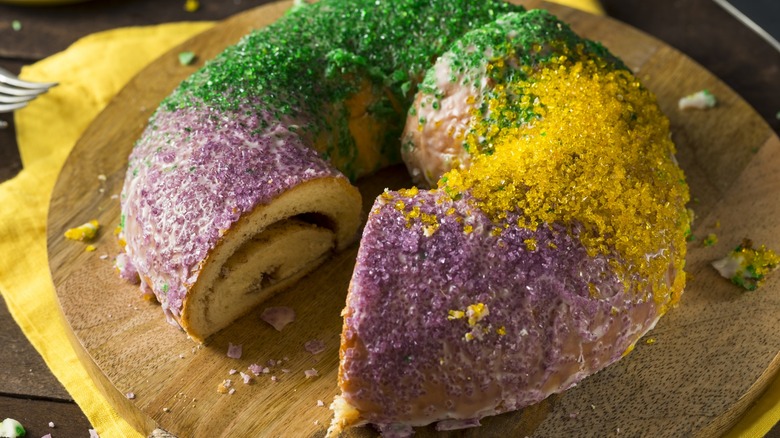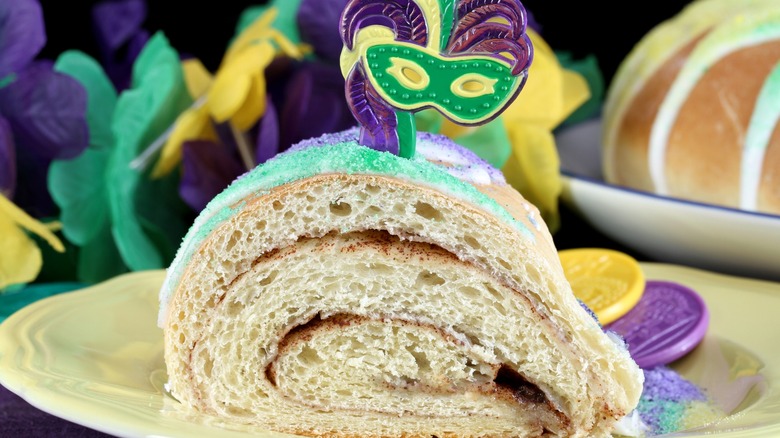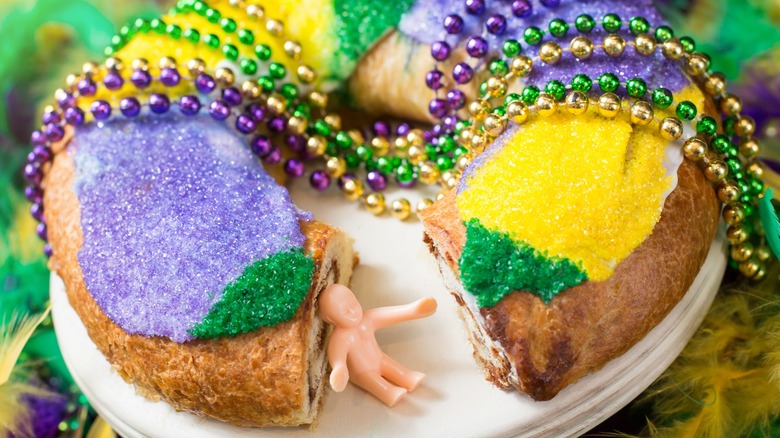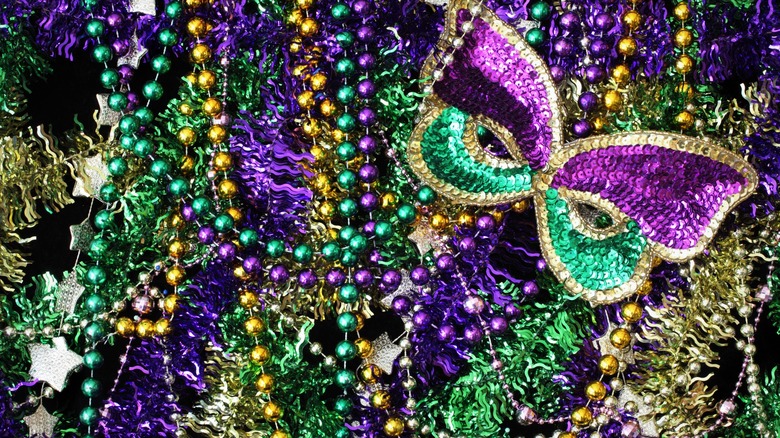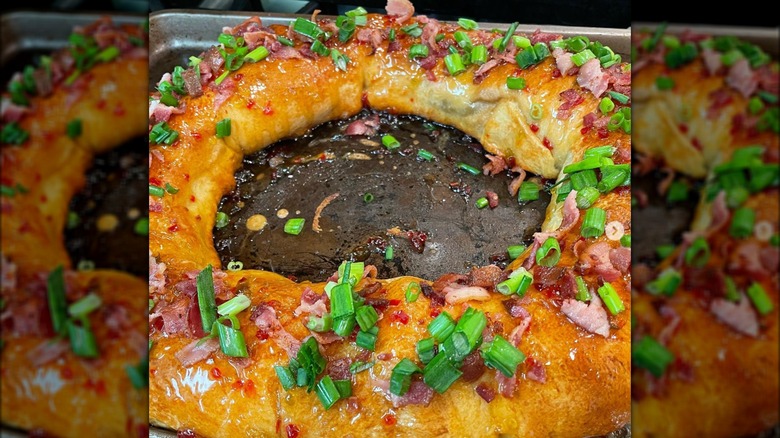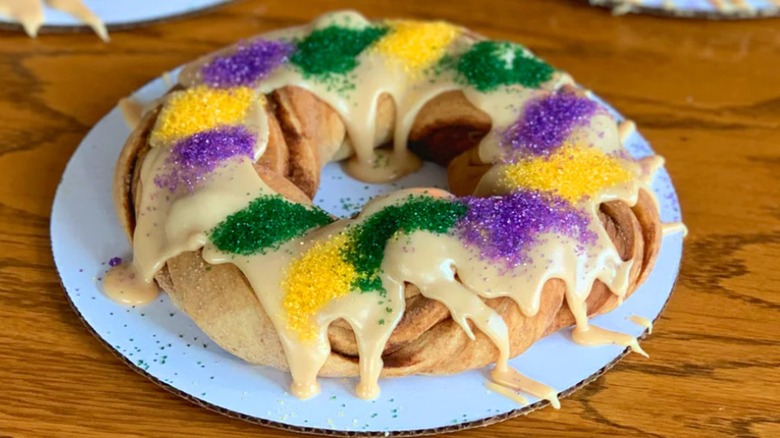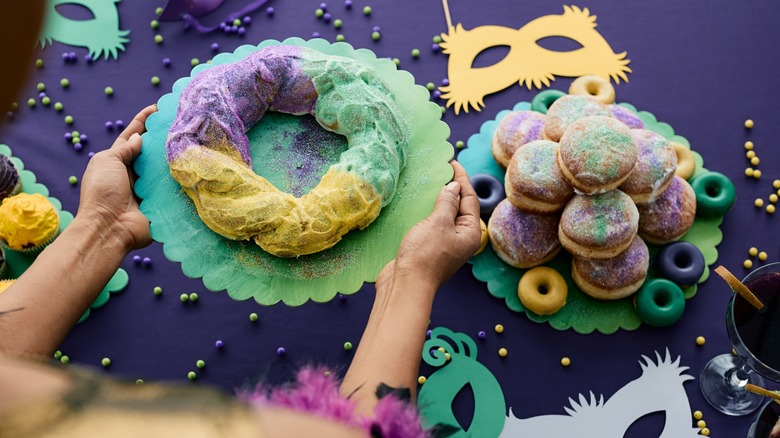What Is King Cake?
In New Orleans, Mardi Gras, or carnival season, is the biggest celebration of the year: houses and sidewalks strewn with strands of beads, parades with colorful floats, picnics, live music, and, of course, great food. Speaking of, there's no food more synonymous with Mardi Gras than King Cake.
In case you're not familiar with this Louisiana specialty, we'll take a look at what exactly King Cake is, where it comes from, where it gets its name from — and what exactly that plastic baby is all about, for those who were wondering. We'll also explain the types of King Cake you'll find — did you know that it can be savory as well as sweet?
Finally, we'll recommend some of the most notable places in NOLA to pick up this delicacy. By the time you've finished reading, you'll have learned everything you need to know about King Cake, and you'll probably be craving it, too. Tis the season!
What is King Cake?
King Cake is actually quite a simple cake. Similar in texture and flavor to brioche, the dough is plaited and shaped into a round with a hollow center, a bit like a cross between a doughnut and a giant cinnamon roll. The cake is flavored with cinnamon and honey. Traditional King Cakes are filled with vanilla or cinnamon-flavored cream and loaded with icing. Sometimes, the icing itself is dyed the typical Mardi Gras colors of purple, yellow, and green. Other times, luster dust or sprinkles are used to add color.
You'll find as many variations of King Cake in NOLA as there are jazz bars — and bakeries across the country have their own takes on this specialty. However, one thing all King Cakes have in common is their shape. They're always round, with a whole in the middle, so they look a bit like a crown. Oh, and they also have a tiny plastic baby hidden inside! More on that later.
The history of King Cake and where it gets its name
When you think of King Cake, you think of Fat Tuesday and Mardi Gras, but the history of this cake goes much deeper. It dates back to the Middle Ages in Europe, when a similar cake was made to celebrate Three Kings Day, also known as Catholic Epiphany. The holiday takes place on January 6, twelve days after Christmas, and celebrates the Three Wise Men's visit to the Baby Jesus, with Catholic families gathering to enjoy dinner and exchange gifts.
King Cake first arrived in Louisana in the 18th century, brought to the city by the French. However, it didn't become associated with Mardi Gras until the 19th century, when Mardi Gras took over from Epiphany as the season's main celebration. Nowadays, King Cake is popular across the U.S. from the start of carnival season in early January until Ash Wednesday in mid-February. And, of course, it's called King Cake in honor of the three kings, or Wise Men, and their twelve-day journey to see the Baby Jesus.
Why is there a plastic baby in King Cake?
Be careful when you're biting into your slice of King Cake — you might get the tiny plastic baby! Some say the baby represents the Baby Jesus, while others think it's for prosperity and good luck. Whatever your beliefs, it's a good thing to find the baby in your slice. You're "crowned" king or queen for the day, and everybody should do your bidding. You're also said to have a prosperous year in store.
The baby is a relatively recent tradition, though, as early King Cakes didn't have anything hidden inside. During the late 19th century, a social group in NOLA known as the Twelfth Night Revelers decided to bake a bean into their King Cake. Whoever found the bean would be crowned king or queen of the ball! Later, in the 1940s, a NOLA baker called Donald Entringer was approached by a traveling salesman with a shipment of tiny French porcelain dolls. He suggested Entringer bake them into King Cakes — as you do. Entringer proceeded to bake and sell the cakes at a commercial bakery, McKenzie's, one of the city's most successful bakeries during the 20th century. When he ran out of the dolls, he headed for the French Quarter where he found little plastic babies for sale, and the tradition was born.
These days the baby usually isn't baked into the cake, for health and safety reasons. If you're buying King Cake at a bakery, it usually comes separately in the container or bag, for you to insert yourself.
What do the colors of King Cake stand for?
Attend any Mardi Gras celebration and you'll notice the masks, beads, and other decorations are always three colors: green, purple, and gold. This isn't random. Traditionally, green symbolizes faith, gold represents power, and purple is for justice. As long as we can remember, these have always been the colors of Mardi Gras, and therefore the colors of King Cake!
However, there is some debate about what each color represents. Historians say the three colors may have been inspired by national flags: During the 19th century, many new nations, such as the U.S. and France, adopted tricolor schemes to symbolize unity. The founders of Mardi Gras may have wanted to invoke a similar scheme for their celebration. An alternative theory surrounding the Mardi Gras colors claims that the founders of the carnival didn't choose green, purple, or gold for their traditional meanings. To them, gold symbolized the richest of metals, while purple stood for the luxurious dye once only worn by the elite in society. The green is said to represent the earth, bringing fertility, growth, and luck.
So although the meaning behind the Mardi Gras colors is slightly mysterious, there's no doubt that they are the representative hues of the carnival. While various different types of King Cake are available to buy, they're almost always decorated with purple, green, and gold icing or sprinkles. It wouldn't be King Cake without those Mardi Gras colors!
What types of King Cake are available?
The "classic" King Cake is flavored with honey and cinnamon and filled with cinnamon or vanilla-flavored cream cheese. But there are so many takes on the classic version out there, especially if you're in NOLA. Many NOLA bakeries serve a praline cream cheese variety — and it's pronounced "prawleen" if you want to fit in with the locals!
Other bakeries have more modern takes, with cream cheese flavors like strawberry and lemon. Then there are those making the King Cake an even more decadent experience, such as Brennan's, whose Banana Fosters King Cake packs in a creamy banana-flavored filling and banana liqueur. Some bakeries use fruit jam as a filling in place of cream cheese.
It doesn't stop there. King Cakes don't even have to be sweet — they can be savory, too! Bywater Bakery does several savory versions, including one with crawfish, as well as a Boudin King Cake with spicy rice sausage.
Where to get King Cakes in NOLA
We've already mentioned a couple of places to get King Cakes in NOLA, but what about the best place for a classic cake? Family-owned Manny Randazzo King Cakes is your best bet, according to many NOLA locals, and if you can't get to the bakery they'll ship direct to your door. If you go in person, expect a line out the door and down the block. As well as the traditional variety, they offer King Cakes filled with various cream cheese flavors, including strawberry, lemon, praline, apple, and more.
Duong Phuong Bakery, NOLA's most established Vietnamese bakery, lets you order King Cakes online or walk in, but be prepared to queue — it's worth it for their Mardi Gras offerings. Other spots to check out include Loretta's Authentic Pralines for praline-flavored cream cheese offerings, La Boulangerie, and Brennans. For more creative takes, try Gracious Bakery, where you can even buy a King Cake kit to make your own at home, or opt for the Frangipane King Cake with almond filling and edible glitter from Bywater Bakery.
How to make your own King Cake: tips and tricks
Don't want to queue for hours to pick up a King Cake in NOLA? You could always make your own. For the easiest option, buy King Cake mix, which you should find in some bakeries, stores, and online around Mardi Gras season.
If you prefer to make your cake from scratch, don't leave it until the last minute. A King Cake recipe could take anywhere from four hours to a few days to make. There are a few tips and tricks to ensure your cake is the best it can be, too. Most importantly, don't forget to buy the tiny plastic baby — how else will anybody become royalty for a day?
Some recipes recommend starting your cake the night before and refrigerating the dough overnight — or even for up to three days! Make sure that your yeast is foamy and activated before adding it to your dough — if it doesn't foam, it's most likely dead and you'll need to start again with fresh yeast. Using softened, room-temperature butter is a must, too — but not melted butter. This makes it easier to combine with the other ingredients to form the dough.
Be sure to heat the milk to the right temperature before adding it to the yeast. If it's too hot, it will kill the yeast, so using a thermometer is a good idea. Finally, refrigerating your dough so you can roll it out when it's cold makes life much easier, as it won't be as sticky as room-temperature dough.
